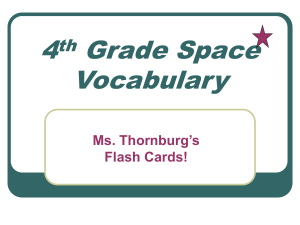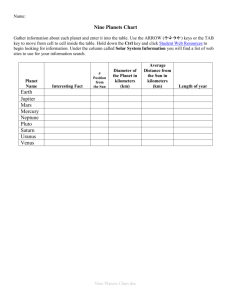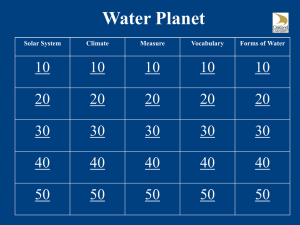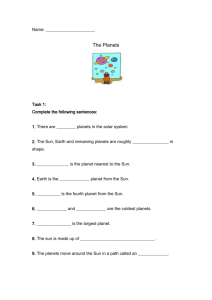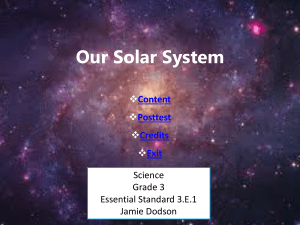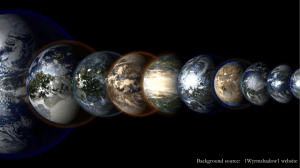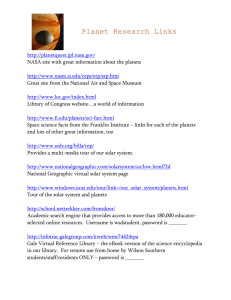Pritikas_presentation
advertisement
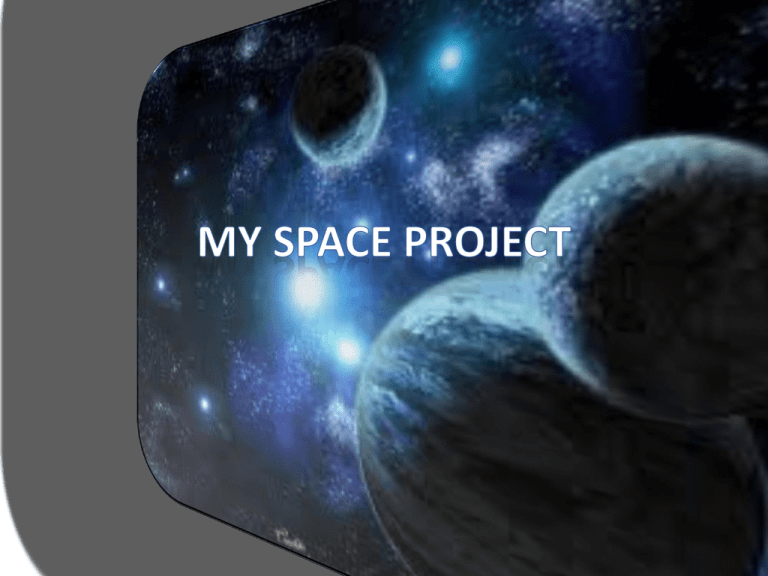
Sun Volume:33x1017 km 3 Diameter: 1.39 million km Mass: 4x1030 kg Minimum/Maximum Surface Temperature: 5,500 °C Effective Temperature: 5504 °C At the core it’s 15 million. The core gives the sun enough energy to give us all the light and heat we all need. The sun’s surface is about 500 km thick. Sun spots are metallic fields that are cooler. http://www.solarviews.com/eng/sun.htm http://hypertextbook.com/facts/2004/AmyChan.shtml http://www.bbc.co.uk/science/space/solarsystem/sun_and_planets http://solarsystem.nasa.gov/planets/profile.cfm?Object=Sun http://www.howstuffworks.com/sun.htm Jupiter Diameter: 142,981 km Orbit Size around the Sun: 778 x 106 km Volume: 1x1015 km Mass: 1x1027kg The fifth planet from the sun is called giant gas planet. It is believed to have liquid metallic hydrogen and helium. It’s also is the biggest planet in our solar system! http://solarsystem.nasa.gov/planets/profile.cfm?Object=Jupit er http://www.universetoday.com/33962/diameters-of-theplanets/ http://www.bbc.co.uk/science/space/solarsystem/sun_and_pl anets/jupiter Saturn Diameter: 120,536 km Orbit Size around the Sun: 1x109km Volume: 827x1015 km3 Mass: 568x1027 kg Saturn has ice partials orbiting it. It’s also the second biggest planet in our solar system. It has 27 satellites. Saturn is mainly composed of hydrogen and helium and does not have a solid surface. http://www.bbc.co.uk/science/space/solarsystem/sun_and_planets/saturn http://www.universetoday.com/33962/diameters-of-the-planets/ http://solarsystem.nasa.gov/planets/profile.cfm?Object=Saturn&Display=Educ http://www.greatfamilycamping.com/planets.html Uranus Diameter: 51,118 km Orbit around the sun: 2x109km Volume: 86x1012 km3 Mass: 86x1024 kg Uranus was correctly identified in 1781 by William Herschel. Like all the other gas planets Uranus doesn’t have any sold surface. Uranus has only been visited once, by the Voyager 2 probe. http://www.bbc.co.uk/science/space/solarsystem/sun_and_planets/uranus http://www.universetoday.com/33962/diameters-of-the-planets/ http://solarsystem.nasa.gov/planets/profile.cfm?Object=Uranus http://en.wikipedia.org/wiki/Uranus Neptune Diameter: 48,682 km Orbit Size around the sun: 4x109 km Volume: 62x1012 km3 Mass: 102x1024 kg Neptune just finished its orbit around the sun in 2011. The big ice planet and the last of the giant gas planets and almost. Neptune 4.5 billion km away from the sun. It cannot be seen from earth. Its diameter is four times that of the Earth's and it is 17 times as massive. http://wchs-astronomy.wikispaces.com/Where+is+the+H2O http://www.bbc.co.uk/science/space/solarsystem/sun_and_planets/neptune http://www.universetoday.com/33962/diameters-of-the-planets/ http://solarsystem.nasa.gov/planets/profile.cfm?Object=Neptune Earth Diameter: 48,682 km Orbit Size around the Sun: 149x106 km Volume: 1x10 12 km3 Mass: 5x1024 kg Minimum/Maximum Surface Temperature: -88/58 (min/max) Earth only has one satellite. Earth was formed about 1.4 million years ago. Life was formed about 1 billion years after. Estimates on how much longer the planet will to be able to continue to support life range for 500 million years, to as long as 2.3 billion years. http://climatehistory.com.au/2010/04/20/first-fleet-googleearth/ http://www.universetoday.com/33962/diameters-of-the-planets/ http://solarsystem.nasa.gov/planets/profile.cfm?Object=Earth Venus Diameter: 12,100 km Orbit around the sun:108x106 km Volume: 928x109 km3 Mass: 4x1024 kg Venus has 224 for a complete orbit of the sun in 2011. Apart from the size Venus is very different from earth. Several spacecrafts have visited Venus. http://en.wikipedia.org/wiki/Venus http://www.universetoday.com/33962/diameters-of-the-planets/ http://solarsystem.nasa.gov/planets/profile.cfm?Object=Venus Mars Diameter: 6,792 km Orbit Size around the Sun: 227x106 km Volume: 163x109 km3 Mass: 641x1021 kg Mars has is known to have seasons. This is made by its small tilt. Volcanos in highlands and plains were active about 3 million years ago. Sciences believe that Mars had big floods. http://nssdc.gsfc.nasa.gov/photo_gallery/photogallery-mars.html http://solarsystem.nasa.gov/planets/profile.cfm?Object=Mars http://www.universetoday.com/33962/diameters-of-the-planets/ Mercury Diameter: 4,878 km Orbit Size around Sun: 57x106 km Volume: 60x109 km Mass: 330x1021 Mercury has craters like on the moon. It has about 88 earth days. Only two spacecrafts has been on Mercury. This planet is not a gas planet. It’s the first planet from the sun. http://celestial-alchemy.com/education/planetarycorrespondences/mercury/ http://www.bbc.co.uk/science/space/solarsystem/sun_and_planets/me rcury_(planet) http://www.universetoday.com/33962/diameters-of-the-planets/ http://solarsystem.nasa.gov/planets/profile.cfm?Object=Mercury Pluto Diameter: 2,302 km Orbit Size around the Sun: 9x109 km Volume: 6x109 km3 Mass: 13x1021 kg Pluto is not a planet. It’s a white dwarf planet. Pluto is the second biggest dwarf planet we know. Pluto is about twothirds the diameter of Earth's Moon and probably has a rocky core. http://space.about.com/od/solarsystem/ig/Pluto-PicturesGallery/Hemisphere-of-Pluto.htm http://wiki.answers.com/Q/What_is_the_diameter_of_Pluto http://solarsystem.nasa.gov/planets/profile.cfm?Object=Saturn&Displa y=Educ The diameter of planets vary and this is the order of biggest to smallest. Planets Diameter Jupiter Saturn Uranus Neptune Earth Venus Mars Mercury Pluto 142,981 km 120,536 km 51,118 km 12,100 km 48,682 km 2,302 km 6,792 km 4,878 km 2302 km http://neography.com/journal/our-solar-system-in-css3/ Let’s Test Your Brains Q1:What are sun spots? A: Metallic fields that are cooler. Q2: How many satellites does Saturn have? A: 27 Q3: Does Mars have seasons? A: Yes, Because of it’s small tilt. Q4: Did sciences believe big floods were on Mars? True or Fault A: True Southern Cross Hope you liked it Peace By Pritika
